[fullwidth backgroundcolor=”” backgroundimage=”” backgroundrepeat=”no-repeat” backgroundposition=”left top” backgroundattachment=”scroll” video_webm=”” video_mp4=”” video_ogv=”” video_preview_image=”” overlay_color=”” overlay_opacity=”0.5″ video_mute=”yes” video_loop=”yes” fade=”no” bordersize=”0px” bordercolor=”” borderstyle=”solid” paddingtop=”5px” paddingbottom=”5px” paddingleft=”0px” paddingright=”0px” menu_anchor=”” equal_height_columns=”no” hundred_percent=”no” class=”” id=””][title size=”1″ content_align=”left” style_type=”single” sep_color=”” class=”” id=””]Pluto : What We’ve Learned[/title][three_fifth last=”no” spacing=”yes” background_color=”” background_image=”” background_repeat=”no-repeat” background_position=”left top” border_size=”0px” border_color=”” border_style=”” padding=”” class=”” id=””][fusion_text]By Shawn Fitzmaurice
- To keep updated on NASA’s New Horizons mission to Pluto, visit the SciWorks Pluto Page.
- Find this and all past SciWorks Radio episodes at http://wfdd.org/programs/sciworks-radio
- Learn how NASA got to Pluto with this special web-only episode of SciWorks Radio.
[/fusion_text][fusion_text] [/fusion_text][fusion_text]
[/fusion_text][fusion_text]
[/fusion_text][/three_fifth]
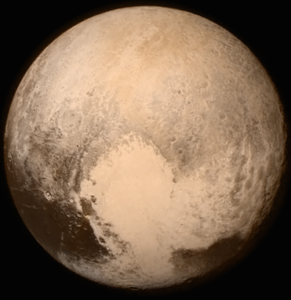
Pluto’s “Heart-shaped region has been unofficially referred to as the Tombaugh Regio-Image Credit: NASA/APL/SwRI
[/fusion_text]
What have we learned from New Horizons since the encounter? Stunning new images show that Pluto and its moon Charon are far more interesting than we imagined. The surfaces are young, suggesting active geology. A now iconic image shows us Pluto’s massive heart-shaped region, which NASA has named the Tombaugh Reggio[/fusion_text][/fullwidth][fullwidth backgroundcolor=”” backgroundimage=”” backgroundrepeat=”no-repeat” backgroundposition=”left top” backgroundattachment=”scroll” video_webm=”” video_mp4=”” video_ogv=”” video_preview_image=”” overlay_color=”” overlay_opacity=”0.5″ video_mute=”yes” video_loop=”yes” fade=”no” bordersize=”0px” bordercolor=”” borderstyle=”solid” paddingtop=”0px” paddingbottom=”5px” paddingleft=”0px” paddingright=”0px” menu_anchor=”” equal_height_columns=”no” hundred_percent=”no” class=”” id=””][fusion_text]
It’s named after Clyde Tombaugh, the man who discovered Pluto in 1930. That’s an area of smooth, what appears to be ice bordered by rough mountains and crater areas that are dark. So, we’re in the process of taking a look at these to see what that material might be made out of. We’ve seen a couple of mountain ranges around the Tombaugh Reggio and one of those is about on the scale of the Rockies in terms of height, and the other is on the scale of the Appalachians.
That’s Jonathan Ward, Volunteer NASA JPL Solar System Ambassador, and author of two brand new books about NASA’s Apollo missions.
Pluto’s Surface, like the surface of many moons in the solar system, is made of super-hard water ice, which acts much like rock does here on Earth. Think of it as “Ice-Tectonics.[/fusion_text][fusion_text]
Some of those mountains have depression on their peaks that look almost like craters on the tops of volcanoes. If indeed these are some sort of crater like that, they would be volcanoes of super-cold liquified gasses, not lava volcanos. Again there’s no appreciable heat inside Pluto that could create Earth-like volcanoes with molten rock.Many of the mountains and some of the land features look like they’re coated with a very dark material, and that’s probably the actual surface material. The other lighter materials that are overlaid on top of that are something else that’s come from either inside the planet or from another source. Some of the Scientists are speculating already that this bright material has come from inside of Pluto, that it welled up from below the surface and then froze once it reached the surface of Pluto. There might be situations where this layer of ice might be sitting on top of other kinds of liquified gasses that are below the surface.
[/fusion_text][/fullwidth][fullwidth backgroundcolor=”” backgroundimage=”” backgroundrepeat=”no-repeat” backgroundposition=”left top” backgroundattachment=”scroll” video_webm=”” video_mp4=”” video_ogv=”” video_preview_image=”” overlay_color=”” overlay_opacity=”0.5″ video_mute=”yes” video_loop=”yes” fade=”no” bordersize=”0px” bordercolor=”” borderstyle=”” paddingtop=”20px” paddingbottom=”20px” paddingleft=”0px” paddingright=”0px” menu_anchor=”” equal_height_columns=”no” hundred_percent=”no” class=”” id=””][fusion_text]
The spacecraft has returned images of some very puzzling features.
[/fusion_text][fusion_text]
There are large flat areas that are broken up into irregular polygons that are several kilometers across. We don’t know if that’s because of the surface collapsing irregularly, or if there’s some heat source that’s causing some of it to melt on the edge of that.
Another thing we found out from Pluto is that it’s thin nitrogen atmosphere extends out almost a thousand miles from the surface of the planet. What we found out also is that the atmosphere is also being stripped off Pluto by interaction with the solar wind, but it’s being replenished somehow and we think that’s probably coming from inside Pluto.
[/fusion_text][/fullwidth][fullwidth backgroundcolor=”” backgroundimage=”” backgroundrepeat=”no-repeat” backgroundposition=”left top” backgroundattachment=”scroll” video_webm=”” video_mp4=”” video_ogv=”” video_preview_image=”” overlay_color=”” overlay_opacity=”0.5″ video_mute=”yes” video_loop=”yes” fade=”no” bordersize=”0px” bordercolor=”” borderstyle=”solid” paddingtop=”5px” paddingbottom=”5px” paddingleft=”0px” paddingright=”0px” menu_anchor=”” equal_height_columns=”no” hundred_percent=”no” class=”” id=””]
Pluto’s largest moon, Charon, is about half the size of Pluto, making it the largest moon in the solar system in relation to its host planet. With its 6-mile deep canyon and mysterious large surface depression, it looks like inspiration for the Death Star
[/fusion_text][fusion_text]
It’s darker material than Pluto. It’s different than what we expected to see. Charon has one feature in one of the closeups that has planetary scientists stumped. It appears to be something like a depression with a large mound inside of it. There’s nothing like that anywhere on Earth or in the rest of the solar system that we’ve seen, so we’re eagerly awaiting a more detailed image to get a better idea of what that might be.
[/fusion_text]
After that, the mission continues on into the Kuiper Belt. This region has trillions of objects made of ice and rock, which are remnants of the formation of our solar system. We’ll get some great data, however…[/fusion_text][fusion_text]
There’s not enough fuel to maneuver it into a different type of orbit. They’ve found some that they can get within a couple million miles of and maybe get some measurements of, but nothing to get the kind of pictures that we’ve gotten of Pluto so far.
[/fusion_text]

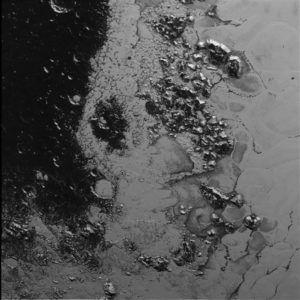
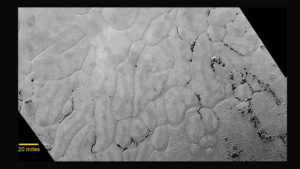
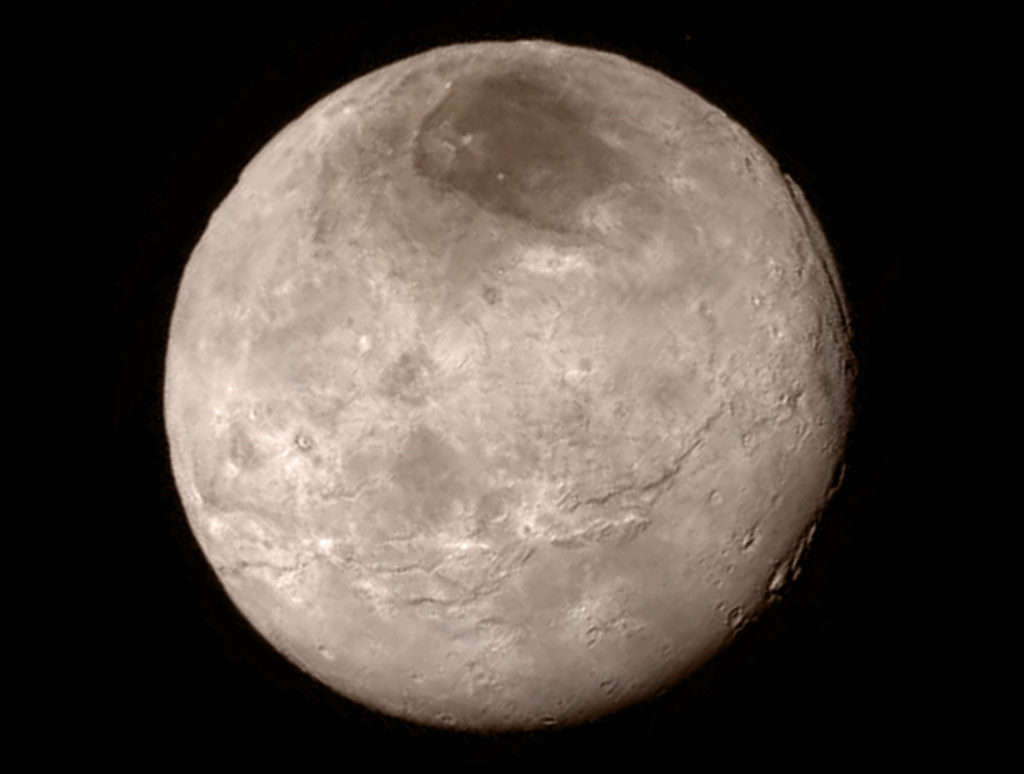
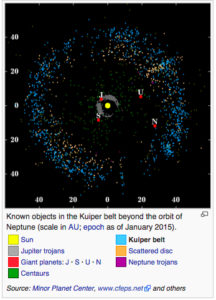
Recent Comments